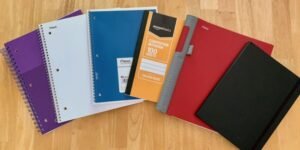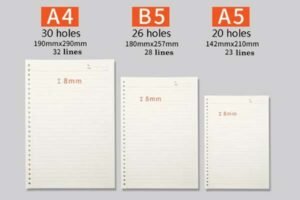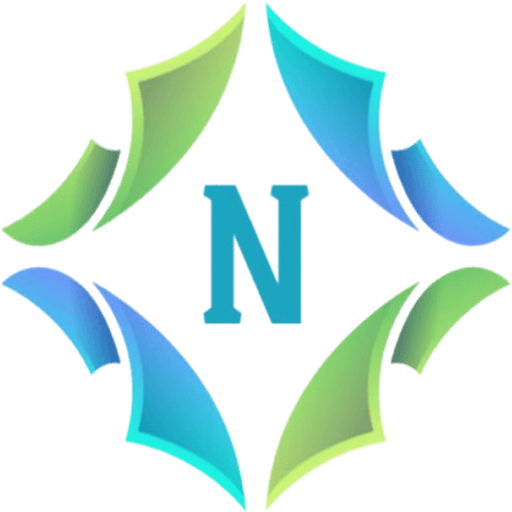
Want a deeper connection with God's Word but feel lost? Maybe traditional study feels a bit dry. Bible journaling1 in a notebook offers a personal, creative, and fulfilling way to engage with scripture.
To Bible journal in a notebook, you select a Bible verse or passage, reflect on its meaning, and then write, draw, or creatively express your insights, prayers, and thoughts directly onto the notebook pages. It’s a personal journey with God's Word.
I remember when I first heard about Bible journaling. I was intrigued. I wanted more than just passively reading. I craved a way to really interact with the scriptures, to make them a part of me. Using a simple notebook opened that door. It wasn’t about creating a masterpiece. It was about creating space for reflection and a more profound understanding.
This method allows you to track your spiritual growth over time. You can see how God has spoken to you through different seasons. It’s less about artistic skill and more about personal worship and study. You simply need a willingness to open your heart and your notebook.
What Supplies Do I Need for Bible Journaling in a Notebook?
Starting any new practice can feel a bit daunting if you think you need lots of special gear. But for Bible journaling in a notebook, it’s simpler than you might imagine.
You'll primarily need a good notebook, your Bible, and reliable pens. Many also enjoy using highlighters, colored pencils, stickers, or washi tape to add a creative touch to their Bible journaling entries, making the process more engaging.

Let's dive deeper into these supplies.
The Notebook Itself
The heart of your journaling is, of course, the notebook.
- Paper Quality: I’ve found that paper around 80gsm is okay for basic writing. But if you plan to use markers or a bit of paint, 100gsm or even 120gsm paper is better. It prevents bleed-through. Acid-free paper is also a good idea because it won't yellow over time. You want your reflections to last!
- Binding:
- Sewn Binding: This is great because the notebook can often lay flat, which is super helpful when you're writing or drawing across two pages.
- Coil/Spiral Binding: These also lay flat and can even fold back on themselves.
- Binder System: Using a refillable binder is fantastic for flexibility. You can add, remove, or rearrange pages. This is something we specialize in at NotebookRing®, adapting to systems like Filofax.
- Size: A5 is a popular choice. It's portable but still offers enough space. B6 is a bit more compact. Think about where you'll be journaling and what feels comfortable.
Writing Tools
You need something to get your thoughts down.
- Pens: I prefer fine-liners or gel pens that don’t smudge easily. Test your pens on a back page first!
- Pencils: Great for initial sketches or light notes before committing with ink.
- Highlighters: Useful for emphasizing key verses or words. Choose colors that don’t obscure the text.
Creative Extras (Optional)
These are not essential, but they can make the process more enjoyable for some. Here’s a quick look:
| Item | Purpose in Bible Journaling | Why I Like It |
|---|---|---|
| Colored Pencils | Adding color, illustrating, highlighting themes | Easy to control, blends well |
| Watercolors | Creating backgrounds, artistic expression | Soft, expressive (use thicker paper!) |
| Washi Tape | Borders, attaching tip-ins, decoration | Adds patterns, easy to reposition |
| Stickers | Thematic elements, verse call-outs | Quick way to add visual interest |
| Sticky Notes | Temporary thoughts, prayer requests | Can move them around |
I started with just a notebook and a pen. Over time, I added a few colored pens. Don't feel pressured to buy everything at once. Start simple.
How Do I Choose a Bible Passage for Journaling?
Staring at the whole Bible can feel overwhelming. Where do you even begin? Choosing a passage is a personal step, but there are many ways to find your focus.
You can choose a Bible passage for journaling2 by following a devotional or reading plan, focusing on verses from a recent sermon, exploring topics you're curious about, or simply praying and asking God to guide you to a specific scripture.
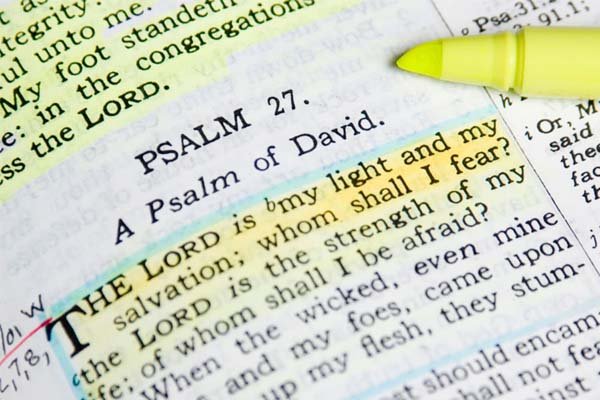
Let's explore these ideas a bit more.
Follow a Reading Plan or Devotional
Many people find this the easiest way to start.
- Devotionals: These often provide a specific verse or short passage for each day, along with some thoughts. This gives you an instant starting point. I often use the devotional's reflection as a springboard for my own journaling.
- Bible Reading Plans: There are plans to read through the entire Bible in a year, or plans focused on specific books or themes. Journaling as you go through a plan can really help solidify what you're reading.
Sermon-Inspired Journaling
This is one of my favorite methods.
- Take Notes: During the church service or while listening to a sermon podcast, jot down the main scriptures and key points.
- Expand Later: In your journaling time, revisit those notes. Write out the scripture. What stood out to you? How did the message challenge or encourage you? I find this really helps me apply the sermon to my life.
Topical Studies
Are you curious about a specific theme, like 'grace,' 'faith,' or 'forgiveness'?
- Use a Concordance: A Bible concordance (many are available online or as apps) can help you find verses related to your chosen topic.
- Journal Through the Theme: Select a few key verses on the topic and journal your thoughts on each one, noticing how the theme develops.
Pray and Listen
Sometimes, the best way is the simplest.
- Ask for Guidance: Before you open your Bible, take a moment to pray. Ask God to lead you to a passage He wants you to reflect on.
- Read Until Something Resonates: Begin reading a chapter or book, and pause when a particular verse or phrase captures your attention. This is often a sign that it's a good place to journal.
I remember a time I was struggling with anxiety. I prayed for guidance, and I opened my Bible randomly to Philippians 4:6-7. That passage became my journaling focus for a week, and it brought me so much peace.
What Are Some Popular Bible Journaling Methods for Notebooks?
Once you have your supplies and your passage, how do you actually journal? There are many creative and structured ways to engage with the text in your notebook.
Popular Bible journaling methods for notebooks include the S.O.A.P. method3 (Scripture, Observation, Application, Prayer), verse mapping, writing out prayers, and artistic responses like lettering or drawing key themes from the passage.
Let's look at a few of these in more detail.
The S.O.A.P. Method
This is a fantastic structured approach, especially if you're new to journaling. S.O.A.P. stands for:
- S - Scripture: Write down the Bible verse or passage you are focusing on. I find that physically writing it helps me slow down and absorb the words.
- O - Observation: What does this passage say? What are the key words or ideas? Who is speaking? Who is the audience? Try to observe without interpreting too much at this stage.
- A - Application: How does this scripture apply to your life right now? What is God saying to you through this passage? This is where it gets personal.
- P - Prayer: Write a prayer based on your reflections. This could be a prayer of thanks, a request for help to apply the lesson, or praise.
Verse Mapping
This is a more in-depth study of a single verse or short passage.
- Write the Verse: Start by writing the verse in the center of your page.
- Break It Down: Look at key words. What do they mean in the original language (you can use online tools like Blue Letter Bible for this)? What are synonyms or related words?
- Cross-References: Are there other verses in the Bible that connect to this one or expand on its theme? Note them down.
- Summarize: In your own words, what is the main message of this verse after your detailed study?
- Personal Takeaway: How does this deeper understanding impact you?
Prayer Journaling
This method focuses on conversation with God.
- Scripture as a Prompt: Read a passage and then simply write out your prayers in response to it.
- List Prayers: You can dedicate sections of your notebook to different prayer categories: thanksgiving, requests, prayers for others, etc.
- Reflect on Answered Prayers: It's powerful to look back and see how God has answered your prayers.
Artistic Expression
If you're more visual, this might be for you.
- Bible Lettering: Choose a key phrase or verse and write it out beautifully. This helps memorize scripture.
- Illustrating Themes: Draw symbols, images, or even abstract designs that represent the meaning or emotion of the passage.
- Mind Maps: Create a visual web of ideas, words, and connections stemming from the scripture.
I often combine methods. Maybe I'll do a quick S.O.A.P. and then spend some time lettering a key phrase that stood out. There are no hard rules – find what helps you connect!
Why Choose NotebookRing® for Your Bible Journaling Notebook?
Finding the right tools can truly enhance your Bible journaling experience. As someone passionate about both scripture and quality stationery, I believe our notebooks at NotebookRing® offer something special.
NotebookRing® provides high-quality, customizable notebooks perfect for Bible journaling. We offer various paper weights ideal for writing or art, durable binding options including lay-flat designs, and eco-friendly materials, ensuring your journal is a lasting companion.
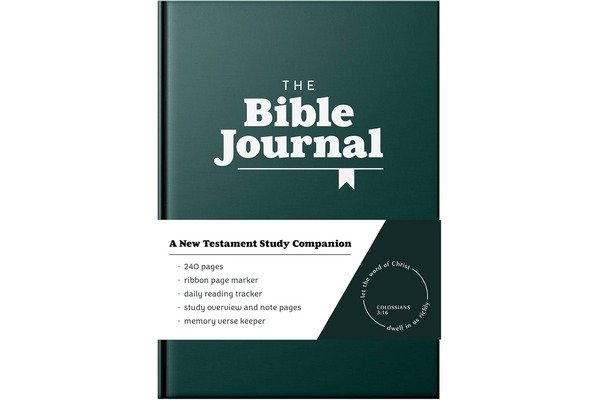
When I think about what makes a great Bible journal, a few things come to mind, and these are areas where we, at NotebookRing®, really focus.
Unmatched Customization for a Personal Touch
Your Bible journal is deeply personal. So, your notebook should be too.
- Cover Options: Imagine having your favorite verse, a meaningful symbol, or your name beautifully hot-stamped or laser-engraved on the cover. We offer these processes.
- Inner Page Selection:
- Paper: Whether you prefer smooth 80gsm for pure writing, or thicker 100-120g acid-free paper to prevent bleed-through from pens or light watercolors, we have options. We even offer recycled paper.
- Format: Choose from lined, grid, dot, or blank pages. Some people like lines for S.O.A.P., while others prefer blank for artistic expression.
- Binding Method:
- Sewing Glue Binding: Our method can allow for a 180° flat design, perfect for writing across the spine.
- Metal Coil/Binder Systems: For those who like flexibility to add or remove pages, our metal binders (compatible with Filofax, Campus, etc.) are robust. Our "seamless coil" technology is something I'm particularly proud of – it’s smooth and won't snag.
A Serious Commitment to Quality
A Bible journal is something you’ll want to keep for years, maybe even a lifetime.
- Durable Materials: We use 304 stainless steel for binder rings and quality paper that stands the test of time. Our FSC™ certification (C106904) means our paper comes from responsibly managed forests.
- Rigorous Testing: We don't just assemble notebooks; we ensure they last. From paper weight tests to binding strength verification, we take quality seriously. I’ve seen our notebooks go through drop tests that simulate real-world shipping and handling.
Eco-Conscious Choices
Being good stewards of creation is important to many of us.
- Sustainable Materials: Beyond FSC-certified paper, we offer options like bagasse fiber covers and soy ink printing.
- Green Commitment: We even donate a sapling for every 100 books sold. It’s a small way we try to give back.
As someone who has been in the notebook manufacturing business since 2006 with NotebookRing®, I've seen how a well-made notebook can become a treasured item. For a practice as meaningful as Bible journaling, having a notebook that feels good in your hands and holds up to your creative expressions can make all the difference. We even offer sample orders, so you can experience the quality yourself.
Conclusion
Bible journaling in a notebook is a rewarding spiritual discipline. It deepens your understanding of scripture and strengthens your relationship with God. Start simply, find what works for you, and enjoy the journey.
-
Explore the transformative practice of Bible journaling to deepen your connection with scripture and enhance your spiritual journey. ↩
-
Discover effective strategies for selecting Bible passages that resonate with you, enhancing your journaling experience. ↩
-
Learn about the S.O.A.P. method to structure your Bible journaling, making your reflections more meaningful and organized. ↩

